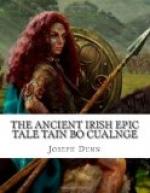[1-1] LU. and YBL. 853.
[2-2] Stowe.
[3-3] LU. and YBL. 857.
[4-4] LU. and YBL. 842-843.
[5-5] H. 2. 17.
[6-6] LU. and YBL. 844.
[7-7] H. 2. 17.
[8-8] H. 2. 17.
[9-9] H. 2. 17.
[10-10] H. 2. 17.
[11-11] H. 2. 17.
[a] The following passage
in ‘rosc’ is exceedingly difficult
and
obscure, and the translation
given here is consequently incomplete and
uncertain.
“Knows not the restless Brown of the [12]truly deadly[12] [W.1502.] fray that is not uncertain?—A raven’s[a] croak—The raven that doth not conceal—Foes range your checkered plain—[1]Troops on raids[1]—I have a secret—Ye shall know ... The waving fields—The deep-green grass ... and rich, soft plain—Wealth of flowers’ splendour—Badb’s cow-lowing—Wild the raven—Dead the men—A tale of woe—Battle-storms[b] on Cualnge evermore, to the death of mighty sons—Kith looking on the death of kin!”
[12-12] LU. and YBL. 846, and Stowe.
[a] The Morrigan, the Irish
goddess of battle, most often appeared in
the form of a raven.
[1-1] Reading with H. 2. 17.
[b] Translating cloe, as suggested by Windisch.
[2]When the Brown Bull of Cualnge heard those words[2] he moved on to Glenn na Samaisce (’Heifers’ Glen’) in Sliab Culinn (’Hollymount’) [3]in the north of Ulster,[3] and fifty of his heifers with him, [4]and his herdsman accompanied him; Forgemen was the name of the cowherd.[4] [5]And he threw off the thrice fifty boys who were wont to play on his back and he destroyed two-thirds of the boys.[5] This was one of the magic virtues of the Brown Bull of Cualnge: Fifty heifers he would cover every day. These calved before that same hour on the next day and such of them that calved not [6]at the due time[6] burst with the calves, because they could not suffer the begetting of the Brown Bull of Cualnge. One of the magic virtues of the Brown Bull of Cualnge were the fifty [7]grown[7] youths who engaged in games, [8]who[8] on his fine back [9]found room[9] every evening [10]to play draughts and assembly[c] and leaping[10]; [11]he would not put them from him nor would he totter under them.[11] Another of the magic virtues of the Brown Bull of Cualnge was the hundred warriors [W.1535.] he screened from the heat and the cold under his shadow and shelter. Another of the magic virtues of the Brown Bull of Cualnge was that no goblin nor boggart nor sprite of the glen dared come into one and the same cantred with him. Another of the magic virtues of the Brown Bull of Cualnge was his musical lowing every evening as he returned to his haggard, his shed and his byre. It was music enough and delight for a man in the north and in the south, [1]in the east and the west,[1] and in the middle of the cantred of Cualnge, the lowing he made at even as he came to his haggard, his shed, and his byre. These, then, are some of the magic virtues of the Brown Bull of Cualnge.




